Text messaging is indeed a form of nonverbal communication, though it lacks traditional visual cues like facial expressions and gestures. Instead, it utilizes elements such as punctuation, emojis, and response timing to convey emotions and intentions. For example, exclamation points can denote excitement, while emojis add an emotional layer to messages. Furthermore, context and cultural differences considerably impact how these cues are interpreted. Understanding these nuances can enhance clarity and meaning in digital interactions. This exploration of text messaging as nonverbal communication opens up further insights into effective communication strategies in our modern world.
Key Takeaways
- Text messaging lacks traditional nonverbal cues like facial expressions and gestures, making emotional tone crucial for interpretation.
- Emotional tone indicators such as punctuation and emojis enhance clarity, serving as substitutes for nonverbal signals.
- Contextual clues, including timing and shared experiences, impact how messages are perceived, influencing emotional understanding.
- Cultural differences affect texting styles and emoji interpretations, highlighting the importance of context in nonverbal communication.
- While texting is primarily verbal, it incorporates nonverbal elements, making it a unique form of communication that requires careful interpretation.
Understanding Nonverbal Communication
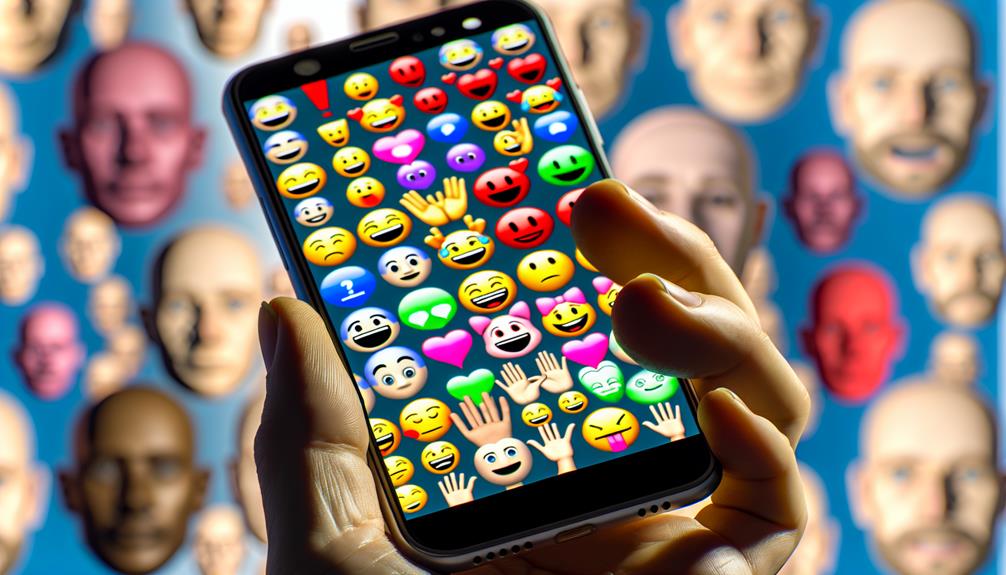
Nonverbal communication encompasses a vast array of signals that convey meaning beyond words, including body language, facial expressions, gestures, and even silence. In today's digital age, where remote interactions are increasingly common, understanding these nonverbal signals is vital for effective interpersonal interactions, as they often complement or contradict verbal communication. For instance, a warm smile can enhance a spoken greeting, while crossed arms may indicate defensiveness despite friendly words. Embracing flexibility in communication styles can also improve remote customer service roles, where nonverbal cues may be limited but still essential for effective interactions.
Nonverbal cues serve as powerful indicators of emotions and intentions, often revealing what is truly felt beneath the surface. Eye contact can signify confidence and interest, while a lack thereof may suggest discomfort or disengagement. Recognizing these subtle signals fosters deeper connections, allowing individuals to respond more empathetically and appropriately.
Moreover, the cultural context can greatly influence the interpretation of nonverbal communication. What may be considered a friendly gesture in one culture could be perceived as offensive in another. Therefore, being attuned to these nuances enhances our ability to navigate diverse social landscapes.
In a world where verbal communication is often the focus, honing the skill of interpreting nonverbal signals can enrich our interactions, fostering a sense of belonging and understanding among individuals.
The Rise of Text Messaging
The advent of text messaging has revolutionized the way we communicate, offering a rapid and convenient means of interaction that transcends geographical boundaries. This form of communication emerged in the late 1990s and has since undergone significant text messaging evolution, shaping the landscape of digital communication trends. As mobile technology advanced, so too did the ability to send and receive messages instantly, fostering a culture of immediacy that caters to our increasingly fast-paced lives. This evolution mirrors the changes in consumer behavior seen in other areas, such as grocery shopping habits, where convenience and speed have become paramount.
Text messaging has become an integral part of our daily interactions, allowing us to connect with family, friends, and colleagues effortlessly. The rise of smartphones further accelerated this trend, providing users with diverse platforms for messaging, including social media and dedicated applications. These developments have not only bridged distances but have also created a sense of belonging among users, as they can easily share experiences and thoughts in real time.
As we navigate this digital age, the implications of text messaging extend beyond mere convenience; it has redefined how we express ourselves and maintain relationships. Understanding these shifts is essential for recognizing the evolving dynamics of communication in our interconnected world.
Elements of Nonverbal Cues
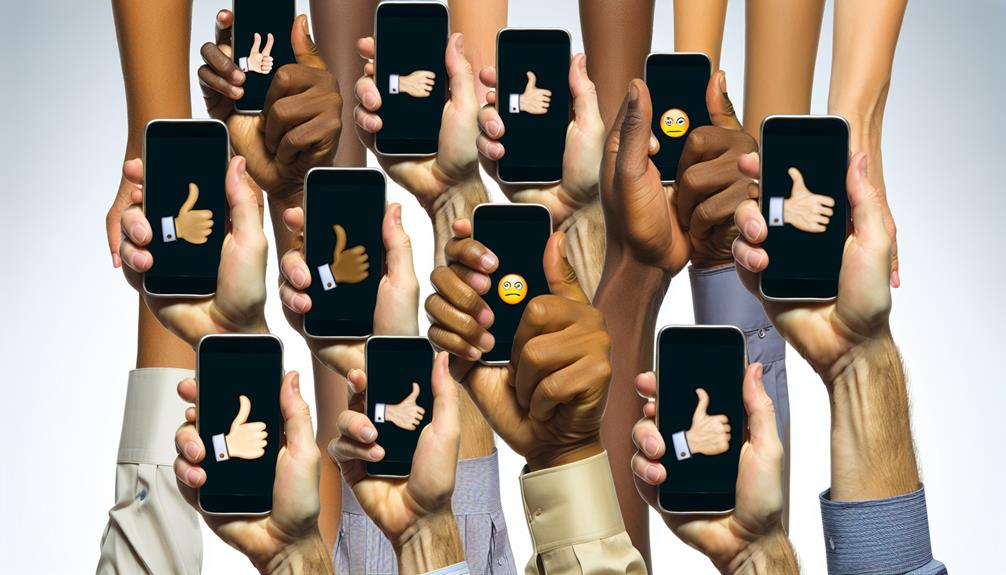
Nonverbal cues play a critical role in communication, influencing how messages are interpreted beyond the spoken word. Key elements such as body language, emotional tone indicators, and contextual clues greatly shape understanding and responses in any interaction. For instance, the soothing effects of certain herbal remedies can enhance emotional states, much like how the calming properties of Sleepytime tea may promote relaxation and improve communication. Recognizing these elements is essential, especially in text messaging, where traditional nonverbal signals are often absent.
Body Language Interpretation
A significant aspect of communication, body language encompasses a variety of nonverbal cues that convey messages beyond spoken words. Among these cues, gestural nuances and facial expressions play pivotal roles in interpreting intentions and emotions. For instance, a subtle shift in posture or a fleeting smile can reveal feelings that words may not articulate, bridging gaps in understanding and fostering connections.
Gestural nuances, such as hand movements or nods, enhance the spoken message, providing emphasis or signaling agreement. They can also indicate discomfort or disinterest when absent, highlighting the importance of physical presence in communication. In contrast, facial expressions serve as immediate indicators of emotional states, often transcending cultural barriers. A frown may denote confusion, while raised eyebrows can signal surprise or curiosity.
Understanding body language requires keen observation and an appreciation for context. While text messaging lacks these rich, nonverbal cues, awareness of one's own body language can improve face-to-face interactions, fostering a sense of belonging. By honing our ability to read and express nonverbal signals, we can create more meaningful connections that resonate beyond the limitations of words.
Emotional Tone Indicators
Utilizing emotional tone indicators can greatly enhance the clarity of communication, particularly in text messaging, where nonverbal cues are absent. These indicators play an essential role in tone interpretation, helping the sender convey emotions that may otherwise be lost in text format. The subtle text nuances, such as punctuation and word choice, can markedly influence how a message is perceived.
The following table illustrates common emotional tone indicators and their implications:
| Indicator | Emotional Tone |
|---|---|
| Exclamation Points (!) | Excitement or urgency |
| Ellipsis (…) | Hesitation or suspense |
| Emojis | Playfulness or sarcasm |
| Capital Letters | Anger or emphasis |
| Dashes (—) | Abruptness or a change in thought |
Contextual Clues Importance
Contextual clues serve as essential elements in understanding communication, especially in text messaging where visual and auditory cues are absent. In this digital landscape, the nuances of conversation rely heavily on contextual understanding and situational awareness to convey meaning effectively. Here are key aspects that illustrate the importance of contextual clues:
- Sender's Intent: Understanding the purpose behind a message can alter its interpretation.
- Recipient's Background: Personal history and shared experiences influence how messages are received.
- Cultural Norms: Different cultures may interpret emojis or abbreviations distinctively.
- Timing and Response: The immediacy or delay of responses can indicate urgency or emotional state.
- Conversation History: Previous exchanges shape expectations and context for ongoing discussions.
Engaging with these clues enables us to navigate the complexities of text messaging, fostering deeper connections. Recognizing that each message carries layers of meaning can enhance interpersonal relationships, promoting a sense of belonging. Therefore, by honing our awareness of contextual elements, we can bridge the gap left by the absence of nonverbal cues, ensuring that our communication remains rich and meaningful.
Emojis and Their Impact
Emojis have rapidly become a ubiquitous feature of digital communication, serving as a powerful tool for conveying emotions and intentions in text messages. This visual language enhances the richness of our interactions, bridging gaps that words alone often leave unfilled. Understanding whipped cream terminology can help illustrate how small elements can greatly enhance the overall experience of communication. Emoji psychology reveals how these small images can evoke feelings and clarify sentiments, allowing users to express nuances that might otherwise be misinterpreted.
For example, a simple smiley face can transform a straightforward message into a warm, welcoming exchange. Conversely, a frowning emoji may indicate dissatisfaction or concern, guiding the recipient's emotional response. This ability to convey complex emotions through images fosters a sense of belonging among users, as they share their feelings in relatable forms.
Moreover, emojis can serve as cultural markers, helping to establish group identity within digital communities. By utilizing specific emojis, individuals can signal alignment with particular social groups or ideologies, reinforcing connections and shared experiences. Ultimately, the impact of emojis in text messaging cannot be overstated; they enrich our communication, making it more relatable and emotionally resonant in an increasingly digital world.
Punctuation as Emotional Indicators
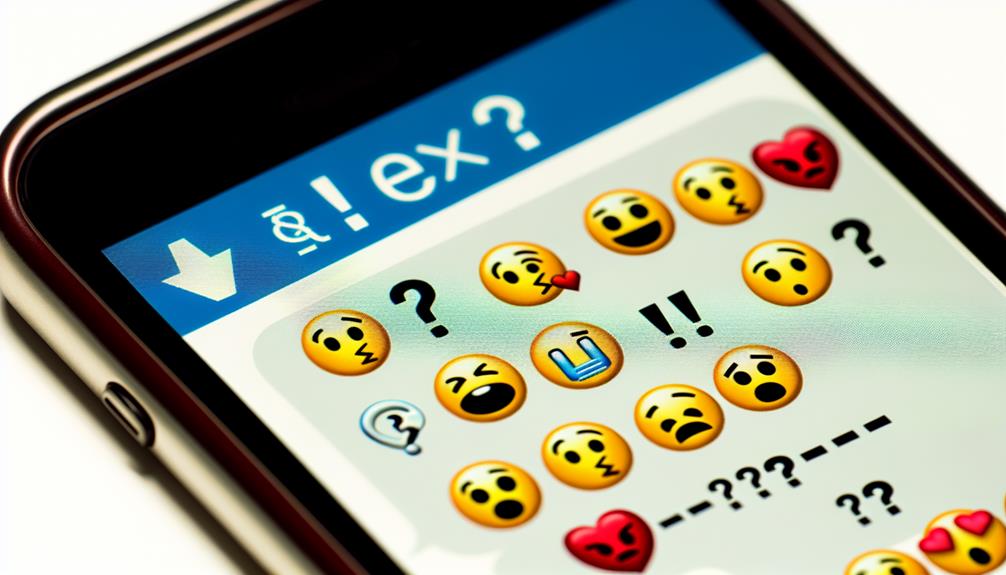
Punctuation marks play an essential role in text messaging, serving as emotional indicators that can greatly alter the tone and meaning of a conversation. The caloric content of eggs may seem unrelated, but just as the nutritional value can influence meal choices, the punctuation impact on the emotional context cannot be overstated. Whether used sparingly or excessively, punctuation can convey nuances that words alone may struggle to express.
Consider the following examples of emotional punctuation:
- Exclamation Marks (!)
- Indicate excitement, enthusiasm, or urgency.
- Ellipses (…)
- Suggest hesitation, uncertainty, or an unfinished thought.
- Question Marks (?)
- Can signify curiosity, confusion, or even sarcasm depending on the context.
- Commas (,)
- Help clarify meaning, often affecting the emotional weight of a message.
- Periods (.)
- Can create a sense of finality or coldness, potentially altering the perceived tone.
Understanding these elements helps foster more meaningful connections in text conversations. By recognizing the emotional punctuation within messages, individuals can better navigate social interactions, enhancing their sense of belonging and emotional understanding in a world increasingly dominated by digital communication.
Timing and Response Dynamics
Timing in text messaging plays an essential role in shaping communication dynamics and can greatly influence the interpretation of messages. Response time serves as an unspoken cue, indicating the sender's level of interest and engagement. For instance, a quick reply may convey enthusiasm, whereas a delayed response can signal disinterest or preoccupation, shaping the recipient's perception of message urgency.
Effective expectation management is important in this digital communication landscape. Individuals often develop unspoken norms around response times, which can lead to misunderstandings if these expectations are not met. Consequently, a deviation from the anticipated timing can disrupt conversation flow, leading to feelings of anxiety or uncertainty.
Moreover, the context often dictates acceptable response times. In professional settings, prompt replies may be expected, while in casual conversations, longer delays can be tolerated. Understanding these dynamics is essential for enhancing interpersonal connections and fostering a sense of belonging.
Ultimately, the timing of responses in text messaging transcends mere logistics; it is a crucial component of nonverbal communication that reflects emotional states and social cues, greatly influencing how relationships are navigated in the digital age.
Texting vs. Face-to-Face Interaction
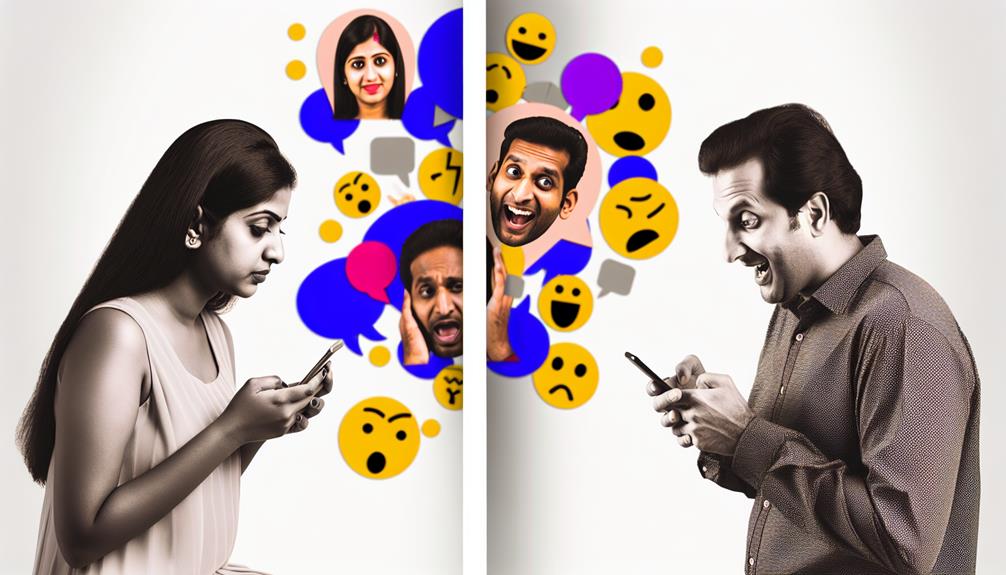
Texting and face-to-face interaction differ considerably in conveying emotional tone, as the latter allows for immediate nonverbal cues such as facial expressions and gestures. In text messaging, the absence of contextual cues can lead to misunderstandings and misinterpretations of intent. Additionally, the speed of response in texting can create a sense of urgency or pressure that is often absent in more personal conversations.
Emotional Tone Differences
Understanding the emotional tone in communication can be challenging, particularly when comparing text messaging to face-to-face interactions. While both forms have their merits, the emotional nuances conveyed through direct interaction often surpass those found in text.
Text interpretation in messaging lacks the richness provided by nonverbal cues, such as facial expressions and body language. This can lead to misunderstandings or misinterpretations of the sender's emotional state. Consider the following differences:
- Facial Expressions: Instantaneous feedback through smiles or frowns.
- Body Language: Subtle cues indicating comfort or discomfort.
- Vocal Tone: Inflections that convey sarcasm, enthusiasm, or sadness.
- Contextual Reactions: Immediate responses that shape the conversation's emotional landscape.
- Shared Environment: The ambiance that can enhance emotional connection.
These elements contribute to a deeper understanding of intent and feeling. In contrast, text messaging often relies on limited emotional cues, which can dilute the richness of interpersonal communication. As we navigate this digital landscape, recognizing these emotional tone differences is essential for fostering connection and belonging in our relationships.
Contextual Cues Absence
While face-to-face interactions inherently provide a wealth of contextual cues, such as physical surroundings and situational dynamics, text messaging often strips away these essential elements. This absence of context can lead to significant contextual ambiguity. In personal conversations, nonverbal signals like body language, eye contact, and tone of voice play critical roles in conveying intent and emotions. Without these cues, text messages may lack clarity, leaving room for message misinterpretation.
For instance, a simple phrase can be interpreted in various ways depending on the relationship between the communicators and the surrounding environment. A sarcastic remark in person may be understood immediately through a smirk or a playful tone, whereas the same text could be read as blunt or offensive. This reliance on written words can create a barrier to genuine understanding, often fostering feelings of isolation rather than belonging.
Moreover, the absence of immediate feedback in text messaging can exacerbate misunderstandings, leading to further disconnect. As we navigate the complexities of communication in a digital age, recognizing the limitations of text messaging is essential for fostering stronger connections and reducing the risk of miscommunication.
Speed of Response
The immediacy of communication in face-to-face interactions contrasts sharply with the often delayed responses typical of text messaging. This difference in response time considerably influences how we perceive urgency in communication and affects our relational dynamics. In an era where quick replies are often expected, text messaging can create misunderstandings about engagement and intent.
Consider the following aspects of response speed in both mediums:
- Instant Feedback: Face-to-face conversations allow for immediate reactions, fostering a sense of connection.
- Delayed Responses: Texting can lead to long waits, which may trigger feelings of anxiety or neglect.
- Misinterpretation: A slow reply can be misread as disinterest, altering urgency perception.
- Time Sensitivity: Certain messages demand prompt responses that are more easily addressed in person.
- Emotional Nuance: Nonverbal cues present in face-to-face interactions are lost in text, impacting the urgency felt by both parties.
Understanding these differences can enhance our communication strategies, promoting a sense of belonging and reducing potential conflicts arising from misinterpretations in response times.
Cultural Differences in Texting
Texting serves as a form of communication that varies considerably across cultures, reflecting diverse social norms and values. Understanding these cultural nuances is essential for effective interactions in our increasingly global society. Different texting styles can reveal much about a culture's approach to communication, whether it be formal, informal, or somewhere in between.
Here is a comparison of texting styles across various cultures:
| Culture | Texting Style | Key Features |
|---|---|---|
| United States | Casual | Use of abbreviations, emojis, and slang |
| Japan | Polite | Emphasis on honorific language and emojis |
| Germany | Direct | Clear, concise messages with minimal emojis |
| Brazil | Expressive | Frequent use of emojis and exclamation marks |
| South Korea | Playful | Use of unique symbols and playful language |
These differences highlight how texting serves not only as a means of communication but also as a reflection of cultural identity. By appreciating these diverse texting styles, we can foster better connections, showing respect and understanding to those from different backgrounds.
Future of Communication Methods
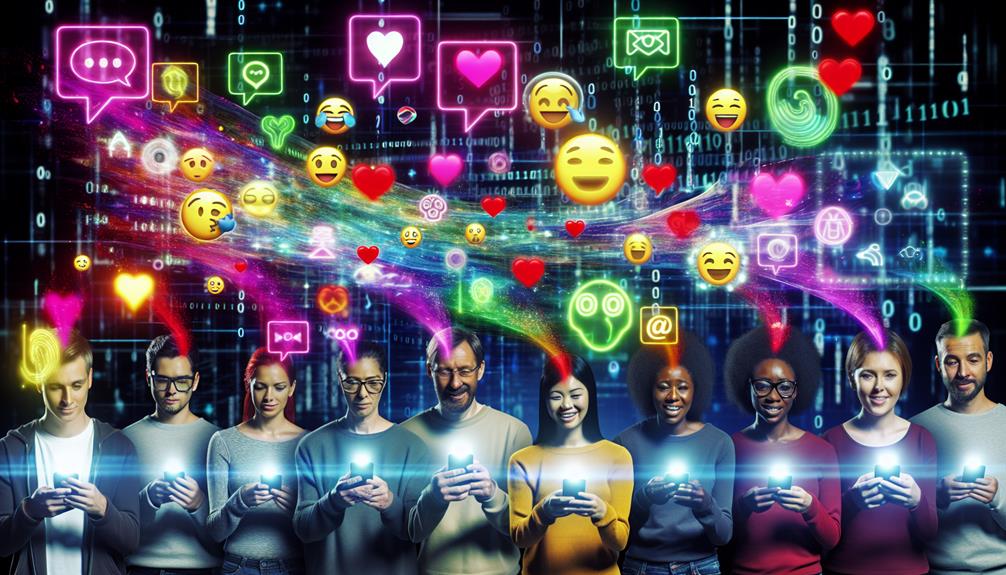
As we look toward the future of communication methods, it becomes evident that technological advancements will continue to shape how we connect with one another. The evolution of communication trends suggests a shift towards more immersive and engaging formats, enhancing our capacity for digital empathy. Future predictions indicate that we will see significant developments in the following areas:
- Virtual reality: Creating immersive experiences that simulate real-life interactions.
- Augmented interactions: Blending digital elements with the physical world to enhance communication.
- AI communication: Utilizing artificial intelligence to facilitate more intuitive exchanges.
- Holographic messaging: Offering three-dimensional representations in conversations, making them more personal.
- Sensory engagement: Incorporating multiple senses to enrich the communication experience.
As technology evolves, these advancements will foster deeper connections, allowing us to express ourselves in ways previously unimaginable. The rise of immersive experiences will not only redefine how we communicate but will also nurture a sense of belonging among individuals in an increasingly digital world. By embracing these innovations, we can look forward to a future where communication transcends traditional boundaries, creating a more connected and empathetic society.
Frequently Asked Questions
Can Text Messaging Replace Face-To-Face Conversations Entirely?
While text messaging offers distinct advantages, such as convenience and immediate communication, it cannot entirely replace face-to-face conversations. Emotional expression is often diluted in text, as nonverbal cues like tone and body language are absent. Although texting fosters connections, the depth of interpersonal relationships thrives through direct interaction, where nuances of emotion and understanding flourish. As a result, while texting is a valuable tool, it should complement rather than substitute personal engagement.
How Do Age Differences Affect Texting Styles?
Age differences greatly influence texting styles, reflecting generational preferences in communication. Younger individuals tend to embrace emoji usage, utilizing these symbols to enhance emotional expression and convey tone. In contrast, older generations may prefer more straightforward text, often valuing clarity over embellishment. This divergence highlights the importance of understanding and adapting to varying texting styles to foster effective communication across age groups, ultimately cultivating a sense of belonging and connection in our increasingly digital world.
Are There Texting Etiquette Rules to Follow?
Texting etiquette is essential for effective communication. Maintaining a respectful texting tone is vital; avoid excessive sarcasm or ambiguity, as these can lead to misunderstandings. Additionally, emoji usage can enhance the emotional context of your messages, but should be used judiciously to avoid misinterpretation. Remember to take into account your audience and the relationship dynamics, ensuring your texting style fosters a sense of belonging and connection rather than alienation.
What Role Does Context Play in Text Message Interpretation?
Context plays a vital role in text message interpretation, as it provides essential contextual cues that shape understanding. The emotional tone conveyed through language, punctuation, and even timing can greatly influence how a message is received. For instance, a seemingly neutral statement can be perceived as sarcastic or affectionate, depending on the relationship and prior interactions. Therefore, recognizing the surrounding context is essential for fostering clear communication and ensuring the intended message resonates with the recipient.
Can Texting Lead to Misunderstandings More Than Verbal Communication?
Texting can indeed lead to misunderstandings more frequently than verbal communication. The absence of verbal cues, such as intonation and facial expressions, often results in ambiguity. Text tone can be misinterpreted, leading to unintended offense or confusion. Additionally, while emoji usage aims to convey emotions, their meanings can vary considerably among individuals. Consequently, the nuances of text communication may hinder clarity, fostering miscommunication and impacting the sense of belonging within conversations.



